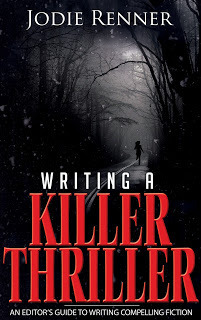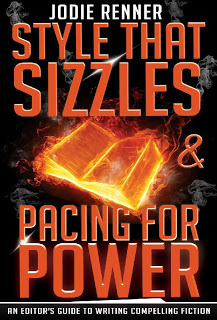10 Things You Don't Want In Your Novel
Crafting a story is a bit like juggling--so many elements must come into play at the right moment to put on an amazing show. There's the strong, compelling hero, damaged in some way that the reader identifies with, up against impossible odds. There's a vivid setting brimming with symbols and foreshadowing. And we can't forget witty dialogue, great pacing, conflict, tension, sensory description and a one-of-a-kind voice. So while we're keeping all these things in the front of our brain as we write, what are the biggest mistakes we want to avoid? Editor Jodie Renner is here to answer that question!
10 NO-NO’S FOR A COMPELLING STORY

Today’s fiction readers are more discerning and busier than ever. They want to be swept away by a captivating story with a charismatic main character. They don’t want to be talked at. Don’t wrench them out of the fictive dream by addressing them as the author to explain things or otherwise taking them out of the character’s immediate world.
Avoid these storytelling gaffes in your novel or short story:
1. Too much description
Avoid writing paragraphs of description of the scenery, weather, and other surroundings. Write only the most compelling details, and from the main character’s point of view – how is the weather affecting her? Are details in his physical environment hindering his goals? And don’t get into too much detailed information on exactly what each character looks like and everything they’re wearing, especially for minor characters. Paint in large brushstrokes, mentioning only the most salient details, those that contribute to characterization.
2. An unlikeable protagonist
Make sure your main character is someone readers will want to bond with, root for, and follow for the whole story. Don’t make him or her cold, arrogant, difficult, demanding, unfeeling, insensitive, dismissive, timid, whiny, or wimpy. Go for sympathetic and likeable, but vulnerable, with some baggage.
3. A cardboard lead
Make sure your hero or heroine is multidimensional, with lots of personality and attitude, and plenty of drive and charisma. They need strengths but also inner conflict and secrets. Nobody wants to follow a bland, wishy-washy, overly ordinary lead character.
4. La-la land – Characters getting along too well
Even allies such as friends and family members should be interacting with some friction and an undercurrent of tension to add interest. If everybody’s getting along just fine, you need to cause some strife. Why? Because in fiction, happy equals boring.
5. Too much backstory
Don’t interrupt the story to give a block of background information on the character – where he grew up, how long he’s been at this job, marital history, etc. Weave in only the most relevant or intriguing details, in small bits as you go along, from his point of view, not as the author, and tie it in with what’s happening – make it directly relevant to the scene. Flashbacks work well, too, but keep them brief, and again, something in the scene causes the character to start thinking about his past. It doesn’t just come out of nowhere.

6. Omniscient point of view
Avoid interrupting the narrative as the author, addressing the readers to explain a point or tell them about future or past events, other characters, or something going on somewhere else, all from outside the viewpoint of the character. Keep the readers in the character’s head and world at that moment, firmly ensconced in the fictive dream.
7. Information dumps
Avoid jumping in as the author to explain technical details or other information to the readers in a lump of exposition. Give them the minimal info they need for the story, still in the character’s point of view, with tension and attitude, through searching or a question-and-answer dialogue with someone else. Style That Sizzles & Pacing for Power goes into more detail on this, with examples and tips.
8. AYKB – “As you know, Bob...”
That’s a form of info dump through dialogue, where one character is telling another something they both know, just to impart that info to the readers, like “As you know, Bob, we used to live on a farm until we moved to the city when you were ten.” Clunky, amateurish and transparent.
9. Too many similar characters and/or characters all sound the same – like the author
Make your characters different enough to add contrast, dissonance and sparks. And make sure each character’s speaking patterns and word choices reflect their gender, age, background, education, interests, and personality. A rough character isn’t going to speak the same way as a professional, and men and women speak quite differently, especially when stressed. This applies to their thoughts as well, of course, and their general internal observations, analysis, and planning.
10. And the biggest storytelling gaffe of all – not enough conflict & tension
Every single scene needs conflict and a change of some kind, to keep readers turning the pages. Every single page needs tension. If your story is lagging, it’s because there isn’t enough discord or friction. If you have any boring scenes or chapters, revise them or delete them, saving any critical parts to add to other scenes. Let the sparks fly and get the readers worrying about your protagonist!

Do you have any more storytelling gaffes to avoid? Let us know in the comments below!
Jodie Renner, a freelance fiction editor specializing in thrillers, has published two books to date in her series, An Editor’s Guide to Writing Compelling Fiction: WRITING A KILLER THRILLER, with the updated, expanded edition now available in e-book and paperback on Amazon; and STYLE THAT SIZZLES & PACING FOR POWER, available in paperback, for Kindle, and in other e-book formats.
For more info, please visit Jodie’s author website or editor website.

10 NO-NO’S FOR A COMPELLING STORY

Today’s fiction readers are more discerning and busier than ever. They want to be swept away by a captivating story with a charismatic main character. They don’t want to be talked at. Don’t wrench them out of the fictive dream by addressing them as the author to explain things or otherwise taking them out of the character’s immediate world.
Avoid these storytelling gaffes in your novel or short story:
1. Too much description
Avoid writing paragraphs of description of the scenery, weather, and other surroundings. Write only the most compelling details, and from the main character’s point of view – how is the weather affecting her? Are details in his physical environment hindering his goals? And don’t get into too much detailed information on exactly what each character looks like and everything they’re wearing, especially for minor characters. Paint in large brushstrokes, mentioning only the most salient details, those that contribute to characterization.
2. An unlikeable protagonist
Make sure your main character is someone readers will want to bond with, root for, and follow for the whole story. Don’t make him or her cold, arrogant, difficult, demanding, unfeeling, insensitive, dismissive, timid, whiny, or wimpy. Go for sympathetic and likeable, but vulnerable, with some baggage.
3. A cardboard lead
Make sure your hero or heroine is multidimensional, with lots of personality and attitude, and plenty of drive and charisma. They need strengths but also inner conflict and secrets. Nobody wants to follow a bland, wishy-washy, overly ordinary lead character.
4. La-la land – Characters getting along too well
Even allies such as friends and family members should be interacting with some friction and an undercurrent of tension to add interest. If everybody’s getting along just fine, you need to cause some strife. Why? Because in fiction, happy equals boring.
5. Too much backstory
Don’t interrupt the story to give a block of background information on the character – where he grew up, how long he’s been at this job, marital history, etc. Weave in only the most relevant or intriguing details, in small bits as you go along, from his point of view, not as the author, and tie it in with what’s happening – make it directly relevant to the scene. Flashbacks work well, too, but keep them brief, and again, something in the scene causes the character to start thinking about his past. It doesn’t just come out of nowhere.

6. Omniscient point of view
Avoid interrupting the narrative as the author, addressing the readers to explain a point or tell them about future or past events, other characters, or something going on somewhere else, all from outside the viewpoint of the character. Keep the readers in the character’s head and world at that moment, firmly ensconced in the fictive dream.
7. Information dumps
Avoid jumping in as the author to explain technical details or other information to the readers in a lump of exposition. Give them the minimal info they need for the story, still in the character’s point of view, with tension and attitude, through searching or a question-and-answer dialogue with someone else. Style That Sizzles & Pacing for Power goes into more detail on this, with examples and tips.
8. AYKB – “As you know, Bob...”
That’s a form of info dump through dialogue, where one character is telling another something they both know, just to impart that info to the readers, like “As you know, Bob, we used to live on a farm until we moved to the city when you were ten.” Clunky, amateurish and transparent.
9. Too many similar characters and/or characters all sound the same – like the author
Make your characters different enough to add contrast, dissonance and sparks. And make sure each character’s speaking patterns and word choices reflect their gender, age, background, education, interests, and personality. A rough character isn’t going to speak the same way as a professional, and men and women speak quite differently, especially when stressed. This applies to their thoughts as well, of course, and their general internal observations, analysis, and planning.
10. And the biggest storytelling gaffe of all – not enough conflict & tension
Every single scene needs conflict and a change of some kind, to keep readers turning the pages. Every single page needs tension. If your story is lagging, it’s because there isn’t enough discord or friction. If you have any boring scenes or chapters, revise them or delete them, saving any critical parts to add to other scenes. Let the sparks fly and get the readers worrying about your protagonist!

Do you have any more storytelling gaffes to avoid? Let us know in the comments below!
Jodie Renner, a freelance fiction editor specializing in thrillers, has published two books to date in her series, An Editor’s Guide to Writing Compelling Fiction: WRITING A KILLER THRILLER, with the updated, expanded edition now available in e-book and paperback on Amazon; and STYLE THAT SIZZLES & PACING FOR POWER, available in paperback, for Kindle, and in other e-book formats.
For more info, please visit Jodie’s author website or editor website.

Published on June 26, 2013 04:00
No comments have been added yet.
Writers Helping Writers
A place for writers to find support, helpful articles on writing craft, and an array of unique (and free!) writing tools you can't find elsewhere. We are known far and wide for our "Descriptive Thesau
A place for writers to find support, helpful articles on writing craft, and an array of unique (and free!) writing tools you can't find elsewhere. We are known far and wide for our "Descriptive Thesaurus Collections" which help authors create vivid imagery and sensory detail for their Settings, Characters (physical descriptions, emotions, skills & talents, etc.), Symbolism, Weather, and a whole bunch more. Stop in and say hello! :) http://writershelpingwriters.net/
...more
- Angela Ackerman's profile
- 1014 followers



